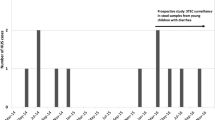Abstract
The objective is to establish the frequency of STEC infections in household contacts of HUS patients. We studied 292 household contacts of 82 HUS patients attended from 2010 to 2018. In HUS cases, diagnostic criteria were (1) isolation and characterization of STEC strains, (2) detection of free fecal Shiga toxin (FFStx), and (3) detection of anti-O serogroup-specific antibodies. Contacts were studied by screening of stx genes by polymerase chain reaction and/or STEC isolation from stool samples. Clonal relation of STEC strains was established by pulsed-field gel electrophoresis (PFGE). Frequencies of HUS patients without STEC isolation with STEC-positive contacts were determined. Serotypes and stx-genotypes in patients and contacts were analyzed. Thirty (36.6%) HUS patients had 36 STEC-positive contacts. Fourteen (38.8%) were children, 20 adults, and 2 dogs. One sibling developed HUS, 6 contacts had gastrointestinal symptoms, and the rest were asymptomatic. In 5 of 30 HUS patients, STEC infection could not be confirmed, and 2 cases were diagnosed only by FFStx detection. Of the remaining 23 HUS patients, 16 had E. coli O157 and 7 E. coli O145 infection. Serotype and/or stx-genotype concordance was established in 19 (83%) of 23 HUS patients and their contacts. Five HUS cases and their contacts studied by PFGE showed macrorestriction patterns with more than 90% similarity. Nearly one third of HUS patients had STEC-positive family contacts, and one third of them were children. Early identification is important to prevent ongoing contamination among family and institutional contacts and to facilitate prompt detection of HUS in STEC-positive contacts.

Similar content being viewed by others
References
Gianantonio C, Vitacco M, Mendilaharzu F, Rutty A, Mendilaharzu J (1964) The hemolytic uremic syndrome. J Pediatr 64:478–491
Gyles CL (2007) Shiga toxin-producing Escherichia coli: an overview. J. Anim. Sci. 85:E45–E62
Karmali MA, Steele BT, Petric M, Lim C (1983) Sporadic cases of hemolytic uremic syndrome associated with fecal cytotoxin and cytotoxin producing Escherichia coli. Lancet i:619–620
Karmali MA, Petric M, Lim C, Fleming PC, Arbus GS, Lior H (1985) The association between hemolytic uremic syndrome and infection by verotoxin-producing Escherichia coli. J Infect Dis 151:775–782
Boletín Integrado de Vigilancia N° 439–SE. Available online: https://www.argentina.gob.ar/sites/default/files/biv_439.pdf. Accessed 6 Feb 2019
Karmali MA (2004) Infection by Shiga toxin-producing Escherichia coli: an overview. Mol. Biotechnol. 26:117–122
Scheutz F, Teel LD, Beutin L, Pierard D, Buvens G, Karch H, Mellmann A, Caprioli A, Tozzoli R, Morabito S, Strockbine NA, Melton-Celsa AR, Sánchez M, Persson S, O‘Brien AD. (2012) A multi-center evaluation of a sequence-based protocol to subtype Shiga toxins and standardize Stx nomenclature. J. Clin. Microbiol. 50:2951–2963
Rivas M, Chinen I, Miliwebsky E, Masana M (2014) Risk factors for Shiga toxin-producing Escherichia coli-associated human diseases. Microbiol. Spectrum 2(5). https://doi.org/10.1128/microbiolspec.EHEC-0002-2013
Ludwig K, Sarkim V, Bitzan M, Karmali MA, Bobrowski C, Ruder H, Laufs R, Sobottka I, Petric M, Karch H, Müller-Wiefel D (2002) Shiga toxin-producing Escherichia coli infection and antibodies against Stx2 and Stx1 in household contacts of children with enteropathic hemolytic uremic syndrome. J Clin Microbiol 40(5):1773–1782
Rivas M, Miliwebsky E, Chinen I, Roldán CD, Balbi L, García B, Fiorilli G, Sosa-Estani S, Kincaid J, Rangel J, Griffin PM, the Case-Control Study Group (2006) Characterization and epidemiologic subtyping of Shiga toxin-producing Escherichia coli strains isolated from hemolytic uremic syndrome and diarrhea cases in Argentina. FoodbornePathog. Dis. 3:88–96
Zotta CM, Chinen I, Lavayén S, Cepeda M, Deza N, Morvay L, Carbonari C, Rearte A, Rivas M (2015) Escherichia coli in household contacts of cases of hemolytic uremic syndrome. Salud y Ciencia 21(2):136–141
Heuvelink AE, Van de Kar NC, Van Der Velden TJ, Chart H, Monnens LA (1999) Verocytotoxin producing Escherichia coli infection in household members of children with hemolytic-uremic syndrome in the Netherlands. Pediatr Infect Dis J 18(8):709–714
Tokuda K, Yahata Y, Sunagawa T (2016) Prevention of secondary household transmission during Shiga toxin-producing Escherichia coli outbreaks. Epidemiol. Infect. 144:2931–2939
Werber D, Mason BW, Evans MR, Salmon RL (2008) Preventing household transmission of Shiga toxin–producing Escherichia coli O157 infection: promptly separating siblings might be the key. Clin Infect Dis 46:1189
Parry SM, Salmon RL (1998) Sporadic STEC O157 infections: secondary household transmission in Wales Emerg. Infect. Dis. 4:657–661
Lopez EL, Diaz M, Devoto S, Grinstein S, Woloj M, Murray BE, Rubeglio E, Mendilaharzu F, Turco M, Vasquez M et al (1991) Evidence of infection with organisms producing Shiga-like toxins in household contacts of children with the hemolytic uremic syndrome. Pediatr Infect Dis J 10(1):20–24
Rivas M, Sosa-Estani S, Rangel J et al (2008) Risk factors for sporadic Shiga toxin-producing Escherichia coli infections in children, Argentina. Emerging Infectious Diseases 14:763–771
Miliwebsky E, Deza N, Chinen I et al (2007) Prolonged fecal shedding of Shiga toxin-producing Escherichia coli among children attending day-care centers in Argentina. Rev Argent Microbiol 39:90–92
Fernández Brando RJ, Bentancor LV, Mejías MP et al (2011) Antibody response to Shiga toxins in Argentinean children with enteropathic hemolytic uremic syndrome at acute and long-term follow-up periods. Plos One 6:e19–e136
Jensen C, Schiellerup P, Olsen KEP, Scheutz F, Petersen E, Gerner-Smidt P, Mølbak K (2005) Antimicrobial treatment of asymptomatic carriers of verocytotoxin-producing Escherichia coli: an empiric study. Scand J Infect Dis 37(1):61–66
Author information
Authors and Affiliations
Corresponding author
Ethics declarations
Conflict of interest
The authors declare that they have no conflict of interest.
Ethical approval
The Review Board and Ethics Committee of the Hospital approved this study.
Informed consent
The requirement to obtain informed consent was waived by the Institutional Review Board.
Additional information
Publisher’s note
Springer Nature remains neutral with regard to jurisdictional claims in published maps and institutional affiliations.
Rights and permissions
About this article
Cite this article
Alconcher, L.F., Rivas, M., Lucarelli, L.I. et al. Shiga toxin-producing Escherichia coli in household members of children with hemolytic uremic syndrome. Eur J Clin Microbiol Infect Dis 39, 427–432 (2020). https://doi.org/10.1007/s10096-019-03738-1
Received:
Accepted:
Published:
Issue Date:
DOI: https://doi.org/10.1007/s10096-019-03738-1




